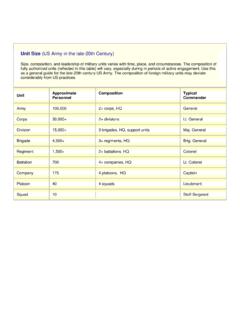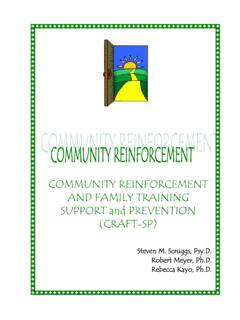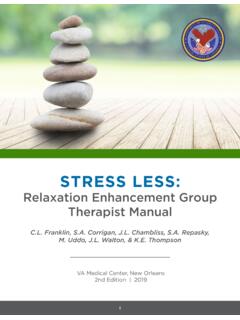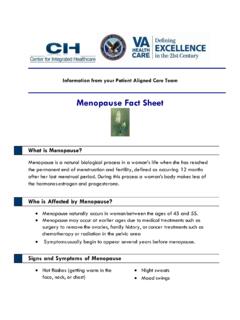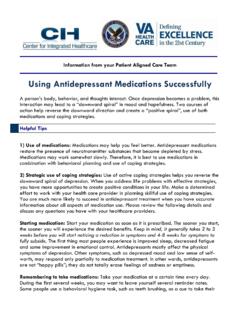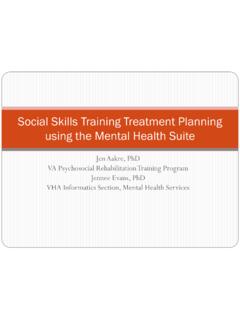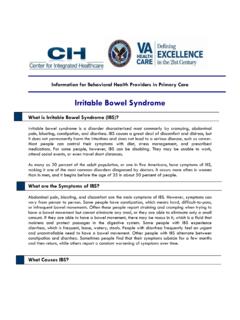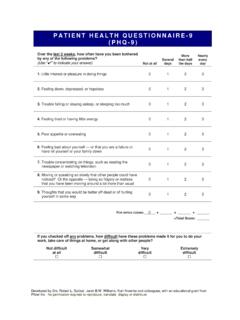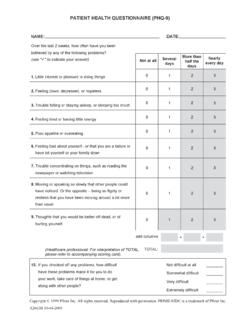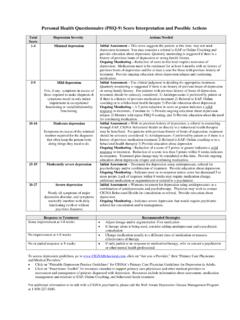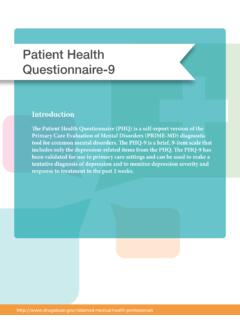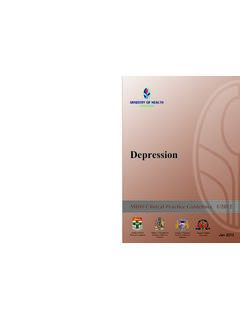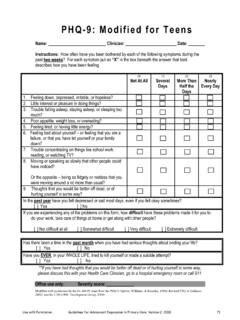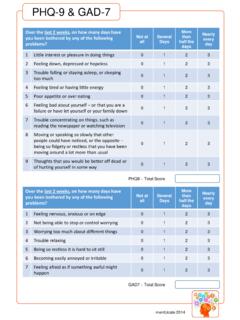Transcription of PHQ-9 What is it? Brief Description - Veterans Affairs
1 How is it administered? PHQ-9 what is it? Brief Description Self-administered 9-item instrument based on the nine DSM-V criteria listed under criterion A for Major Depressive Disorder. The instrument aids in guiding criteria based diagnosis of depressive symptoms, can assist in identifying treatment goals, determining severity of symptoms, as well as guiding clinical intervention. When considering a diagnosis, the clinician will still need to use clinical interviewing skills to determine whether the symptoms are causing clinically significant distress or impairment and those symptoms are not better explained or attributed to other conditions ( substance use, medical conditions, bereavement, etc.)
2 Why should I use it? Clinical Utility Measurement based care emphasizes the use of standardized assessments, and other tests to help personalize care and guide treatment decisions. o Just as a primary care provider would routinely check glucose levels to better inform their treatment plan for a patient s diabetes, routinely administering rating scales to monitor improvement or a change in mental health symptoms is considered best practice in providing optimal care. Routinely using these tools to measure longitudinal changes and track treatment progress are associated with superior client outcomes when compared to usual care.
3 O Assessments alert clinicians to lack of progress, guides treatment decisions, identifies potential intervention targets, and assists in differential diagnosis o Assessments prompt changes in interventions if needed when things are not working or can prompt stepdown in care after a patient s functioning has improved The data can be used by the clinician to engage the client in therapeutic process, overall validating them as an active partner in their health care and mental wellness It can improve communication between providers and facilitate collaboration among different services How easy is it to do? Administration Where and when can it be done?
4 Self-administered by the patient (preferred) Waiting area prior to session Beginning, during, or end session By interviewer in person or via telephone At home prior to appointment How is data collected? How long does it take? Paper and pencil 2-5 minutes to complete BHL Software Tablets or other electronic device PHQ-9 Assessment Resources developed by the VISN 4 MIRECC. Please contact with any questions or comments. mild depressive symptoms PHQ-9 How do I use this? Scoring and Interpretation Responders are asked to rate the frequency of depression symptoms in the last 2 weeks on a Likert scale ranging from 0-3.
5 Items are summed to provide a total score. 0 = not at all 2 = more than half the days 1 = several days 3 = nearly every day Diagnostic Aid: Major Depressive Episode: patient has answered at least more than half the days on 5 or more items (or at least several days on item 9), with one of the items being items 1 or 2 Severity Measure: The total score serves as a marker of severity and distress. Total Score Depression Severity 1-9 minimal depressive symptoms 10-14 15-19 moderate depressive symptoms 20-27 severe depressive symptoms How can this help me with my patients? Treatment Planning Potential Treatment Recommendations by total score Total Score Depression Severity Recommendations Treatment Setting 1-9 Minimal Subsyndromal Depression Monitoring Psycho-Education Integrated Primary Care/Collaborative care model 10-14 Mild Psycho-Education Evidence-based monotherapy Pharmacotherapy Psychotherapy Combination therapy for those who did not respond to an appropriate trial of monotherapy Integrated Primary Care/Collaborative care model 15-19 Moderate Evidence-based monotherapy Pharmacotherapy Psychotherapy Combination therapy for those who did not respond to an appropriate
6 Trial of monotherapy Initial combination therapy Integrated Primary Care/Collaborative care model Specialty Mental Health Care 20-27 Severe Combination of pharmacotherapy and evidence-based psychotherapy Specialty Mental Health Care Clinic PHQ-9 Assessment Resources developed by the VISN 4 MIRECC. Please contact with any questions or comments. PHQ-9 Potential Treatment Interventions by individual items This measure was created to be used in its entirety to assist in capturing the overall clinical picture and to guide treatment planning. However, some suggestions on possible techniques, useful interventions, and referral ideas to consider based on elevated responses on specific items are included below.
7 1) Diminished interest or pleasure i n most things SMART Goal setting Homework assignments Encourage social activities 2) Depressed mood Pleasant events scheduling Identifying maladaptive thoughts/feelings 3) Insomnia/Hypersomnia Administer ISI for more info Psycho-education regarding sleep hygiene 4) Fatigue or energy loss SMART Goal setting Encourage physical activities 5)Change in weight/appetite Food diary Nutrition education SMART Goal setting 6) Feelings of worthlessness or inappropriate guilt Identifying maladaptive thoughts/feelings Challenging maladaptive thoughts/feelings 7) Trouble concentrating Deep breathing exercises Guided imagery exercise Challenging maladaptive thoughts/feelings 8) Psychomotor agitation or retardation Deep breathing exercises Guided imagery exercise Progressive muscular relaxation 9) Recurrent thoughts of death / suicidal ideation Risk Assessment Direct to Urgent Care Services Direct to ER/911 Refer to specialty care Measuring Change Standard definition: Good clinical care requires that clinicians monitor patient progress.
8 Determining clinically significant change recommends a person move from a depressed range (defined as scores greater than or equal to 10) pre-treatment to a non-depressed range (defined as scores less than or equal to 9) post-treatment. Improvement in scores should be 50% or greater of the patients pre-treatment score; a 5 point or more change in scores indicates reliable change. Can I trust it? Psychometric properties Reliability: high in internal reliability, test/retest reliability Validity: high in criterion and construct validity References PHQ-9 Assessment Resources developed by the VISN 4 MIRECC.
9 Please contact with any questions or comments. PHQ-9 Hopko, , Lejuez, , Ruggiero, , & Eifert, (2003). Contemporary behavioral activation treatments for depression: Procedures, principles, and progress. Clinical Psychological Review, 23(5), 699-717 Kroenke, K., Spitzer , & Williams (2001). The PHQ9: Validity of a Brief depression severity measure. Journal of General Internal Medicine, 16(9), 606-613. Louzon, S. A., Bossarte, R., McCarthy, J. F., & Katz, I. R. (2016). Does suicidal ideation as measure by the PHQ-9 predict suicide among VA patients? Psychiatric Services in Advance doi: Nieuwsma, , Trivedi, , McDuffie, J., Kronish, I.
10 , Benjamin, D., & Williams, (2012) Brief psychotherapy for depression: A systematic review and meta-analysis. International Journal of Psychiatry Medicine, 43(2), 129-151. Ross, J. T., Tenhave, T., Eakin, A. C., Difilippo, S., & Oslin, D. W. (2008). A randomized controlled trial of a close monitoring program for minor depression and distress. Journal of General Internal Medicine, 23(9), 1379-1385 Rubenstein, , Chaney, , Ober, S., Fleker, b., Sherman, , Lanto, A., & Vivell, S. (2010). Using evidence-based quality improvement methods for translating depression collaborative care research into practice. Families, Systems, & Health, 28(2), 91-113.
